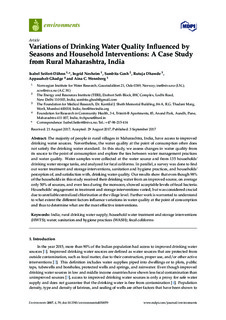| dc.contributor.author | Seifert-Dähnn, Isabel | |
| dc.contributor.author | Nesheim, Ingrid | |
| dc.contributor.author | Gosh, Sambita | |
| dc.contributor.author | Dhawde, Rutuja | |
| dc.contributor.author | Ghadge, Appasaheb | |
| dc.contributor.author | Wennberg, Aina Charlotte | |
| dc.date.accessioned | 2018-06-15T07:39:29Z | |
| dc.date.available | 2018-06-15T07:39:29Z | |
| dc.date.created | 2018-03-19T16:49:49Z | |
| dc.date.issued | 2017 | |
| dc.identifier.citation | Environments. 2017, 4 (59), 16. | nb_NO |
| dc.identifier.issn | 2076-3298 | |
| dc.identifier.uri | http://hdl.handle.net/11250/2501711 | |
| dc.description.abstract | The majority of people in rural villages in Maharashtra, India, have access to improved drinking water sources. Nevertheless, the water quality at the point of consumption often does not satisfy the drinking water standard. In this study, we assess changes in water quality from its source to the point of consumption and explore the ties between water management practices and water quality. Water samples were collected at the water source and from 135 households’ drinking water storage tanks, and analyzed for fecal coliforms. In parallel, a survey was done to find out water treatment and storage interventions, sanitation and hygiene practices, and households’ perception of, and satisfaction with, drinking water quality. Our results show that even though 98% of the households in this study received their drinking water from an improved source, on average only 50% of sources, and even less during the monsoon, showed acceptable levels of fecal bacteria. Households’ engagement in treatment and storage interventions varied, but was considered crucial due to unreliable centralized chlorination at the village level. Further work is warranted to understand to what extent the different factors influence variations in water quality at the point of consumption and thus to determine what are the most effective interventions. | nb_NO |
| dc.language.iso | eng | nb_NO |
| dc.publisher | MDPI | nb_NO |
| dc.rights | Navngivelse 4.0 Internasjonal | * |
| dc.rights.uri | http://creativecommons.org/licenses/by/4.0/deed.no | * |
| dc.title | Variations of Drinking Water Quality Influenced by Seasons and Household Interventions: A Case Study from Rural Maharashtra, India | nb_NO |
| dc.type | Journal article | nb_NO |
| dc.type | Peer reviewed | nb_NO |
| dc.description.version | publishedVersion | nb_NO |
| dc.rights.holder | © 2017 by the authors | nb_NO |
| dc.source.pagenumber | 16 | nb_NO |
| dc.source.volume | 4 | nb_NO |
| dc.source.journal | Environments | nb_NO |
| dc.source.issue | 59 | nb_NO |
| dc.identifier.doi | 10.3390/environments4030059 | |
| dc.identifier.cristin | 1574124 | |
| dc.relation.project | Norges forskningsråd: 216064 | nb_NO |
| cristin.unitcode | 7464,30,22,0 | |
| cristin.unitcode | 7464,20,16,0 | |
| cristin.unitname | Vann og samfunn | |
| cristin.unitname | Systemer og teknologi | |
| cristin.ispublished | true | |
| cristin.fulltext | original | |
| cristin.qualitycode | 1 | |

